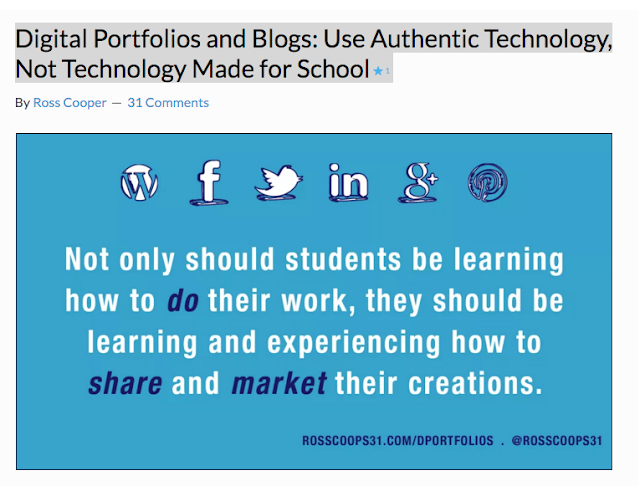I subscribe to a "paper.li" spider that hunts for articles about digital portfolios. Here are some of the blog posts that the paper.li has found.
Ross Cooper has a book coming out soon.
Here are some important points from Ross Cooper's blog:
- Teaching digital citizenship is now a non-negotiable, and this upcoming school year we are rolling out the Common Sense Media Digital Citizenship Curriculum across all grade levels. Now, if we’re then simultaneously having students leverage “safe” made for school technology because we’re afraid what might happen, they’re missing out on valuable opportunities to apply what they’ve learned. In fact, in this context, I would go as far to say we’d be a bit hypocritical by first declaring, “Digital citizenship is important; let’s practice it!” and then saying, “Use this, because we don’t want you to experience what’s out there.” (Of course, the exception would be if we’ve chosen a certain tool due to it’s lower cost, because we want a simple interface for lower grade levels, etc.) Nevertheless, experiences with authentic tools allow for students to apply what they’ve learned in settings that very much mimic the real world. And, at the same time, teachers are present to turn mistakes into beneficial lessons.
- Teaching entrepreneurialism is quickly becoming a non-negotiable, and we’re doing our students a disservice if they’re simply handing in all work for an audience of one, the teacher. Not only should students be learning how to do their work, they should be learning and experiencing how to share and market their creations. While this idea may begin with students simply “copying and pasting” their finished products into their portfolios and then sharing them out (pretty much worst-case scenario)…in time, students can be creating and promoting their own businesses, publishing and marketing eBooks, gaining loyal audiences with podcasts, etc., all of which are only possible with an authentic platform…Everyone, no matter the age, has access to the same “business growing” technologies (many of which aren’t all that complicated, by the way). So, if it’s what adults “do,” our students should be doing it as well.
- The resumé is dead, or dying. If our students are applying for colleges without digital footprints, we’re doing them a disservice.
- He recommends that we read this article. (And, if we’re applying for jobs without digital footprints, we’re doing ourselves a disservice). Need convincing? Hop over to Google and search for “resumé is dead” or check out this article right here…In short, we need to make sure our students are searchable. So, when their names are plugged into Google by a prospective college or employer, not only will no damaging content be found, but students will be given a leg up on the competition due to digital footprints we helped them build…Kidblog won’t show up on a Google search, and neither will Seesaw. And, while programs such as Weebly and Wix are easy to use, I would rather have students get acquainted with a tool that’s used on 25 percent of all websites. In fact, once they graduate high school, with a few clicks they can easily export their portfolios from a district or company server (if necessary) and upload the content to their own website and server space, independent of any district or school.

No comments:
Post a Comment